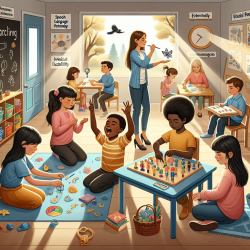Introduction
In the quest to enhance communication skills among children with Autism Spectrum Disorder (ASD) and Intellectual Disability (ID), educators and therapists are constantly exploring innovative methods. A recent study titled "Modifying a Naturalistic Language Intervention for Use in an Elementary School Classroom" sheds light on how Naturalistic Language Interventions (NLIs) can be effectively adapted for elementary school settings. This blog aims to guide practitioners in applying these findings to improve outcomes for children with communication challenges.
Understanding Naturalistic Language Interventions
Naturalistic Language Interventions are designed to leverage a child's interests and motivations to promote communication. These interventions are particularly beneficial for children who are minimally verbal, as they encourage the use of expanded forms of expressive communication, such as multi-word phrases. The study in question evaluated the effectiveness of an NLI in a classroom setting, targeting children with ASD and ID who had previously shown limited response to traditional interventions.
Key Findings from the Study
The study employed a multiple probe design across children, conducted in a public school classroom. It revealed several critical insights:
- Increased Communication: All three children in the study demonstrated increased use of the target behavior compared to baseline sessions.
- Variability in Responses: While two children showed consistent improvement, one child's progress was more variable, indicating the need for individualized approaches.
- Importance of Dosage: The study highlighted that the number of intervention trials per session could significantly influence outcomes, rather than just the duration or rate of trials.
Implications for Practitioners
For practitioners aiming to implement NLIs in classroom settings, the study offers valuable guidance:
- Capitalize on Natural Opportunities: Integrate NLIs during naturally occurring classroom activities, such as play and mealtimes, to promote spontaneous communication.
- Customize Interventions: Tailor interventions to meet the unique needs of each child, considering their interests and current communication abilities.
- Monitor and Adjust Dosage: Pay attention to the number of trials and adjust as necessary to optimize communication outcomes.
Encouraging Further Research
While this study provides promising results, it also underscores the need for further research. Practitioners are encouraged to explore additional components of NLIs and consider conducting their own studies to contribute to the growing body of evidence supporting these interventions.
Conclusion
By integrating the findings of this study into practice, educators and therapists can make significant strides in enhancing communication skills among children with ASD and ID. The journey towards effective communication is ongoing, and with each step, we move closer to unlocking the full potential of every child.
To read the original research paper, please follow this link: Modifying a Naturalistic Language Intervention for Use in an Elementary School Classroom.










